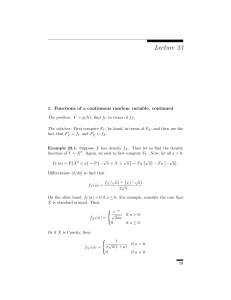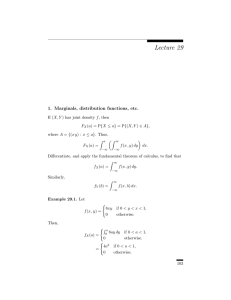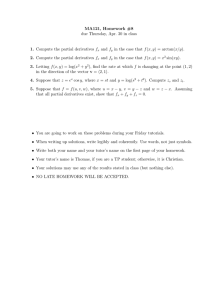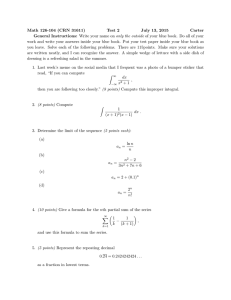Continuous joint distributions (continued)
advertisement
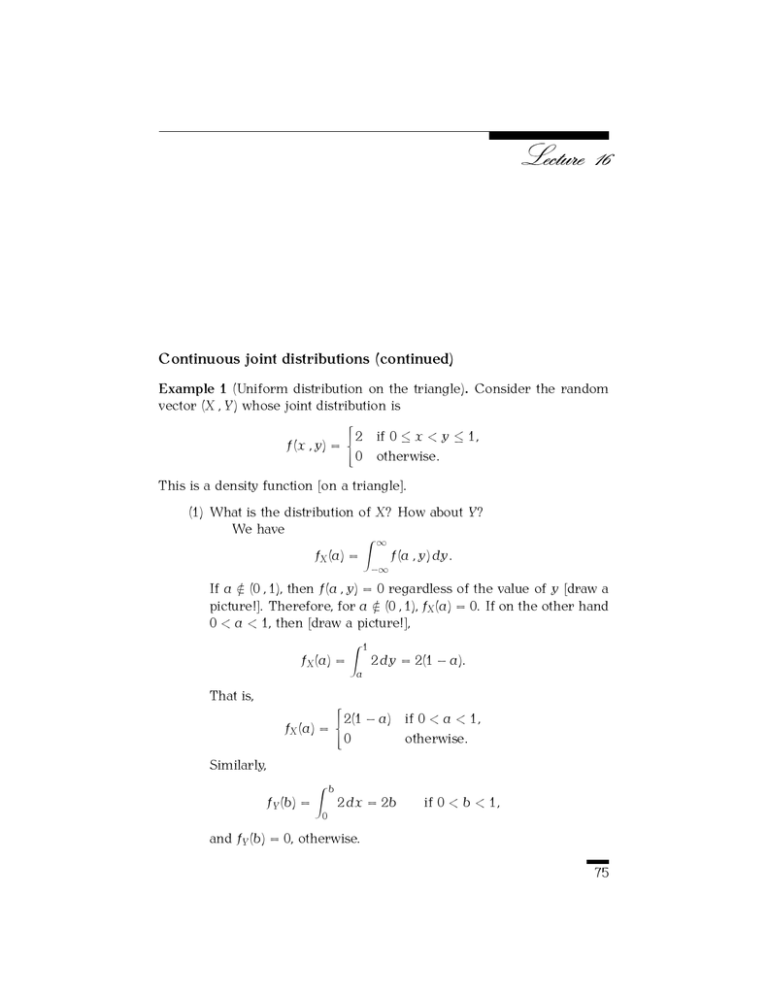
Continuous joint distributions (continued)
Example 1 (Uniform distribution on the triangle). Consider the random
vector (X � Y ) whose joint distribution is
�
2 if 0 ≤ � < � ≤ 1�
�(� � �) =
0 otherwise�
This is a density function [on a triangle].
(1) What is the distribution of X? How about Y ?
We have
� ∞
�X (�) =
�(� � �) ���
−∞
If � �∈ (0 � 1), then �(� � �) = 0 regardless of the value of � [draw a
picture!]. Therefore, for � �∈ (0 � 1), �X (�) = 0. If on the other hand
0 < � < 1, then [draw a picture!],
� 1
�X (�) =
2 �� = 2(1 − �)�
That is,
Similarly,
�
�
2(1 − �) if 0 < � < 1�
�X (�) =
0
otherwise�
�Y (�) =
�
0
�
2 �� = 2�
and �Y (�) = 0, otherwise.
if 0 < � < 1�
75
76
16
(2) Are X and Y independent?
No, there exist [many] choices
�� of (� � �) such that �(� � �) = 2 �=
�X (�)�Y (�). In fact, P{X < Y } =
� = 1 [check!].
(3) Find EX and EY . Also compute the SDs of X and Y .
Let us start with the means:
EX =
�
similarly,
Also:
2
E(X ) =
0
�
0
Similarly,
2
E(Y ) =
�X (�)
�
� �� �
� 2(1 − �) �� = 2
1
EY =
1
�
�
0
0
1
0
� 2 2� �� =
1
2
� �� − 2
�
0
1
�Y (�)
����
2
� 2� �� = �
3
� 2 2(1 − �) �� =
1
1
1
6
�
�
VarX =
Var(Y ) =
√
Consequently, SD(X) = SD(Y ) = 1/ 18.
� 2 �� =
1
;
3
1 1
1
− =
�
6 9
18
1 4
1
− =
�
2 9
18
(4) Compute E(XY ).
After we draw a picture [of the region of integration], we find
that
�
� 1� 1
� 1 �� �
� 1
1 3
1
E(XY ) =
2�� �� �� = 2
�
� �� �� = 2
� �� = �
4
0
�
0
0
0 2
(5) Define correlation as in the discrete. Then what is the correlation
between X and Y ?
The correlation is
�1 2�
1
E(XY ) − EXEY
1
4 − 3 × 3
ρ :=
= 1
= �
1
√ × √
SD(X)SD(Y )
2
18
The distribution of a sum
18
Suppose (X � Y ) has joint density �(� � �). Question: What is the distribution
of X + Y in terms of the function �?
The distribution of a sum
77
FX+Y (�) = P{X + Y ≤ �} =
=
�
∞
�
−�+�
−∞
�−∞
∞ � �
−∞
−∞
�(� � �) �� ��
�(� � � − �) �� ���
Differentiate [�/��] to obtain the density of X + Y , using the fundamental
theorem of calculus:
� ∞
�X+Y (�) =
�(� � � − �) ���
−∞
An important special case: X and Y are independent if �(� � �) = �X (�)�Y (�)
for all pairs (� � �). If X and Y are independent, then
�X+Y (�) =
�
∞
−∞
�X (�)�Y (� − �) ���
This is called the convolution of the functions �X and �Y .
Example 2. Suppose X and Y are independent exponentially-distributed
random variables with common parameter λ. What is the distribution of
X + Y?
We know that �X (�) = λ�−λ� for � > 0 and �X (�) = 0 otherwise. And
�Y is the same function as �X . Therefore,
� ∞
�X+Y (�) =
�X (�)�Y (� − �) ��
�−∞
� �
∞
−λ�
=
λ�
�Y (� − �) �� =
λ�−λ� λ�−λ(�−�) ��
0
= λ 2 ��−λ� �
0
provided that � > 0. And �X+Y (�) = 0 if � ≤ 0. In other words, the sum
of two independent exponential (λ) random variables has a gamma density with parameters (2 � λ). We can generalize this (how?) as follows: If
X1 � � � � � X� are independent exponential random variables with common
parameter λ > 0, then X1 + · · · + X� has a gamma distribution with parameters � = � and λ. A special case, in applications, is when λ = 21 . A
gamma distribution with parameters � = � and λ = 12 is also known as
a χ 2 distribution [pronunced “chi squared”] with � “degrees of freedom.”
This distribution arises in many different settings, chief among them in
multivariable statistics and the theory of continuous-time stochastic processes.
�
78
The distribution of a sum (discrete case)
16
It is important to understand that the preceding “convolution formula” is a
procedure that we ought to understand easily when X and Y are discrete
instead.
Example 3 (Two draws at random, Pitman, p. 144). We make two draws at
random, without replacement, from a box that contains tickets numbered
1, 2, and 3. Let X denote the value of the first draw and Y the value of the
second draw. The following tabulates the function �(� � �) = P{X = � � Y =
�} for all possible values of � and �:
possible value for X
1
2
3
possible 3 1/6 1/6
0
values
2 1/6 0
1/6
for Y
1 0 1/6
1/6
We want to know the distribution of X + Y = the total number of dots
rolled. Here is a way to compute that: First of all, the possible values of
X + Y are 3� 4� 5. Next, we note that
1
P{X + Y = 3} = P{X = 2 � Y = 1} + P{X = 1 � Y = 1} = �
3
1
P{X + Y = 4} = P{X = 1 � Y = 3} + P{X = 3 � Y = 1} = �
3
1
P{X + Y = 5} = P{X = 2 � Y = 3} + P{X = 3 � Y = 2} = �
3
The preceding example can be generalized: If (X � Y ) are distributed
as a discrete random vector, then
P{X + Y = �} =
�
�
P{X = � � Y = � − �};
When X and Y are independent, the preceding simplifies to
�
P{X + Y = �} =
P{X = �} · P{Y = � − �};
�
This is a “discrete convolution” formula.
The distribution of a ratio
The preceding ideas can be used to answer other questions as well. For instance, suppose (X � Y ) is jointly distributed with joint density �(� � �). Then
what is the density of Y /X?
The distribution of a ratio
79
We proceed as we did for sums:
�
�
Y
FY /X (�) = P
≤�
X
�
�
�
�
Y
Y
=P
≤� � Y >0 +P
≤�� Y <0
X
X
= P{Y ≤ �X � X > 0} + P{Y ≥ �X � X < 0}
� ∞ � ��
� 0 � ∞
=
�(� � �) �� �� +
�(� � �) �� ��
=
0
�
0
−∞
∞� �
−∞
−∞
�(� � ��) ��� �� +
�
0
��
−∞
�
�
∞
�(� � ��) ��� ���
Differentiate, using the fundamental theorem of calculus, to arrive at
�Y /X (�) =
=
�
0
�
∞
∞
−∞
�(� � ��) � �� −
�
�(� � ��)|�| ���
0
−∞
�(� � ��)� ��
In the important special case that X and Y are independent, this yields the
following formula:
�Y /X (�) =
�
∞
−∞
�X (�)�Y (��)|�| ���
Example 4. Suppose X and Y are independent exponentially-distributed
random variables with respective parameters α and β. Then what is the
density of Y /X? The answer is
�Y /X (�) =
=
�
∞
�0 ∞
0
�
α�−α� �Y (��)� ��
α�−α� β�−β�� � ��
∞
[if � > 0; else, �Y /X (�) = 0]
��−(α+β�)� ��
0
� ∞
αβ
=
·
��−� ��
[� := (α + β�)�]
(α + β�)2 0
αβ
αβ
=
· Γ(2) =
�
2
(α + β�)
(α + β�)2
= αβ
80
16
for � > 0 and �Y /X (�) = 0 for � ≤ 0. In the important case that α = β, we
have
1
if � > 0�
�Y /X (�) = (1 + �)2
0
otherwise�
Note, in particular, that
� � � ∞
Y
�
E
=
�� = ∞�
X
(1 + �)2
0
Example 5. Suppose X and Y are independent standard normal random
variables. Then a similar computation shows that
�Y /X (�) =
1
π(1 + �2 )
for all real ��
[See Example 5, p. 383 of your text.] This is called the standard Cauchy
density. Note that the Cauchy density does not have a well-defined expectation, although
�� ��
� ∞
� ∞
�Y �
1
|�|
2
�
E �� �� = ·
��
=
·
�� = ∞�
2
X
π −∞ 1 + �
π 0 1 + �2
Exercise. One might wish to know about the distribution of Y /X when Y
and X are discrete random variables. Check that if X and Y are discrete
and P{X = 0} = 0, then
�
� �
Y
P{X = �} · P{Y = ��}�
P
=� =
X
��=0
Note that if we replace the sum by an integral and probabilities with densities we do not obtain the correct formula for continuous random variables
[|�| is missing!].
Functions of a random vector
Basic problem: If (X� Y ) has joint density �, then what, if any, is the joint
density of (U� V ), where U = �(X� Y ) and V = �(X� Y )? Or equivalently,
(U� V ) = T(X� Y ), where
�
�
�(� � �)
T(� � �) =
�
�(� � �)
Functions of a random vector
81
Example 6. Let (X� Y ) be distributed uniformly in the circle of radius R > 0
about the origin in the plane. Thus,
1
if � 2 + � 2 ≤ R2 �
�X�Y (� � �) = πR2
0
otherwise�
We wish to write (X� Y ), in polar coordinates, as (R� Θ), where
�
R = X 2 + Y 2 and Θ = arctan(Y /X)�
Then, we compute first the joint distribution function FR�Θ of (R� Θ) as
follows:
FR�Θ (� � �) = P{R ≤ � � Θ ≤ �}
= P{(X� Y ) ∈ A}�
where A is the “partial cone” {(� � �) : � 2 + � 2 ≤ �2 � arctan(�/�) ≤ �}. If �
is not between 0 and R, or � �∈ (−π � π), then FR�Θ (� � �) = 0. Else,
��
FR�Θ (� � �) =
�X�Y (� � �) �� ��
=
�
0
A
�� �
0
1
� �� �θ�
πR2
�
after the change of variables � = � 2 + � 2 and θ = arctan(�/�). Therefore, for all � ∈ (0 � R) and � ∈ (−π � π),
2
� �
if 0 < � < R and −π < � < π�
FR�Θ (� � �) = 2πR2
0
otherwise�
It is easy to see that
Therefore,
�R�Θ (� � �) =
� �
�R�Θ (� � �) = πR2
0
∂2 FR�Θ
(� � �)�
∂�∂�
if 0 < � < R and −π < � < π�
otherwise�
The previous example can be generalized.
Suppose T is invertible with inverse function
�
�
�(� � �)
−1
T (� � �) =
�
�(� � �)
The Jacobian of this transformation is
∂� ∂�
∂� ∂�
−
�
J(� � �) =
∂� ∂�
∂� ∂�
82
16
Theorem 1. If T is “nice,” then
�U�V (� � �) = �X�Y (�(� � �) � �(� � �))|J(� � �)|�
Example 7. In the polar coordinates example(� = �, θ = �),
�
�(� � �) = � 2 + � 2 �
θ(� � �) = arctan(�/�) = θ�
�(� � θ) = � cos θ�
�(� � θ) = � sin θ�
Therefore, for all � > 0 and θ ∈ (−π � π),
Hence,
J(� � θ) = (cos(θ) × � cos(θ)) − (−� sin(θ) × sin(θ))
= � cos2 (θ) + � sin2 (θ) = ��
�
��X�Y (� cos θ � � sin θ)
�R�Θ (� � θ) =
0
if � > 0 and π < θ < π�
otherwise�
You should check that this yields Example 6, for instance.
Example 8. Let us compute the joint density of U = X and V = X + Y .
Here,
�(� � �) = �
�(� � �) = � + �
Therefore,
Consequently,
�(� � �) = �
�(� � �) = � − ��
J(� � �) = (1 × 1) − (0 × −1) = 1�
�U�V (� � �) = �X�Y (� � � − �)�
This has an interesting by-product: The density function of V = X + Y is
� ∞
�V (�) =
�U�V (� � �) ��
−∞
� ∞
=
�X�Y (� � � − �) ���
−∞
